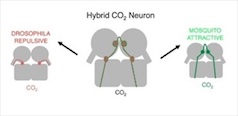
In the course of a histology-based mutagenesis screen where morphological organization of three different classes of ORNs (Or47a, Or47b, Gr21a) were analyzed, we isolated mutants in a miR-279, which specifically affects the CO2 sensory circuitry. This is a particularly interesting circuit as it presents the advantage of known peripheral neural components as well as a robust olfactory behavior in Drosophila, and exhibits behavioral and morphological plasticity among different insects. For example, detection of CO2 in Drosophila is accomplished using two evolutionarily conserved receptors (Gr21a/Gr63a) expressed on a subset of antennal neurons and results in an avoidance response. These neurons project to a single, ventral glomerulus in the AL. By contrast to Drosophila, mosquitoes use CO2 as an attractive odorant to locate their hosts through neurons located in the MP, and target a medial glomerulus. In miR-279 mutants, the anatomy of the CO2 sensory system in Drosophila is switched into an arrangement that resembles a hybrid between flies and mosquitoes. Thus, miR-279 pathway might have lead to the divergence of species-specific behavioral responses to CO2 by mosquitoes and fruit flies.
We speculated that miR-279 mutant reveals an evolutionary intermediate state between Drosophila and mosquito CO2 circuitry. Natural selection can work on such a hybrid neuron to generate different combinations of odorant receptors, and wiring patterns depending on the selective pressures that the insect is exposed to in its environment. For example, it can match up a CO2 receptor program with a ventral or medial targeting program; ventral targeting may drive attraction as is seen in Drosophila while medial targeting may promote the CO2 attraction characteristic of mosquitoes. We hypothesize that regulatory mechanisms presumably have evolved which have allowed such differential coupling of different receptors to different targeting programs that in turn allow for evolutionary flexibility. These mechanisms may aid generation of different olfactory responses to the same odorant, such as attraction versus repulsion, or to different odorants in different species.
 Based on the phenotype exhibited in miR-279 mutant, we are currently trying to dissect: (1) cellular and molecular mechanisms regulating the position and connectivity of CO2 neurons during morphological speciation of this circuitry in fruit flies and mosquitoes, (2) function of miR-279 pathway in driving these processes and (3) the relationship of circuit morphology to behavioral output in response to CO2.
Based on the phenotype exhibited in miR-279 mutant, we are currently trying to dissect: (1) cellular and molecular mechanisms regulating the position and connectivity of CO2 neurons during morphological speciation of this circuitry in fruit flies and mosquitoes, (2) function of miR-279 pathway in driving these processes and (3) the relationship of circuit morphology to behavioral output in response to CO2.